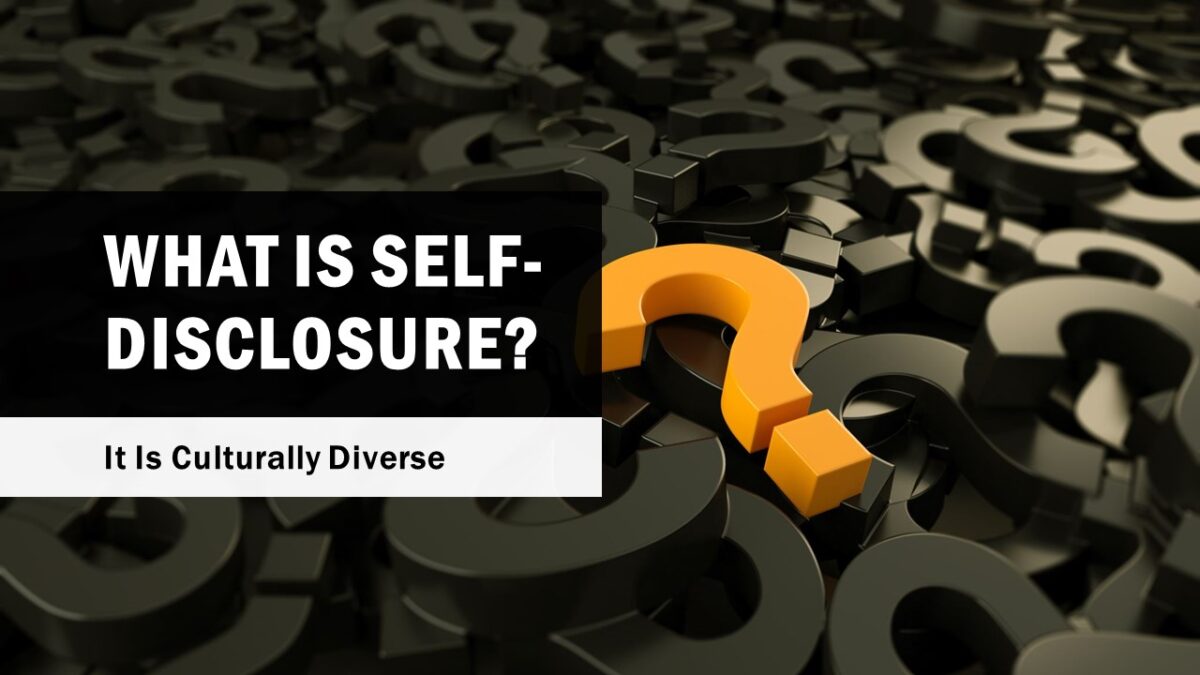Self-disclosure is the way an individual communicates and shares personal information with another. Values and opinions, goals and aspirations, plans and thoughts, feelings and preferences, achievements and failures, fears and hopes, dreams and disappointments—all these internal personal things can be disclosed. They can be private and confidential to a greater or lesser extent. Some information can be sensitive because it makes a person vulnerable in a relationship.
Self-disclosure can be verbal or nonverbal. People differ in their willingness to self-disclose.
Cultural patterns of self-disclosure in romantic and marital relationships vary across societies. Societies differ in their cultural norms of how close the interpersonal relationship between partners should be and how emotionally intimate they should be in a close relationship.
Intimacy as Self-disclosure
Self-disclosure of personal information is the way to express intimacy in relationships. Partners do this both verbally and nonverbally. Many Western scholars and laypeople conceptualize intimacy as self-disclosure, as the way of revealing personal values, thoughts, and feelings to another person. Many European Americans consider such experiences and expressions as important things for personal growth and relationship satisfaction, while many Asians and Asian Americans don’t think this way.(Altman & Taylor, 1973; Derlega, et al., 1993; Ignatius & Kokkonen, 2007; Jourard, 1971; Sprecher & Hendrick, 2004, see Karandashev, 2019, for review).
Cultural Differences in Self-disclosure
Cross-cultural studies have shown that the degree of self-disclosure between American partners is usually higher than between Japanese or Chinese partners. These cultural differences might be due to their differences in individualism and collectivism as cultural values (Barnlund, 1975; Chen, 1995; Hocker and Wilmot, 1995; Gudykunst & Nishida, 1983; Ting-Toomey, 1991; see for a review, Karandashev, 2019).
For instance, spouses in North America communicate verbally more than Chinese spouses. Self-disclosure is frowned upon in Chinese culture, which encourages greater self-restraint in marital communication and limited self-disclosure. These differences can be due to differences in corresponding cultural values. Alternatively, people in different cultures can express their personal information and feelings in various ways (Chen, 1995; Hocker & Wilmot, 1995; Fitzpatrick et al., 2006; Juang & Tucker, 1991; see Karandashev, 2019 for a review).
The boundaries and meanings of privacy, intimacy, and self-expression may differ across cultures. Various aspects of what is viewed as private, intimate, and public are culturally determined (Coffey, 2017; Heitler, 2012; Moore, 2003).
Self-disclosure in Individualistic Western Cultures
Western individualistic cultures consider self-disclosure as the prototypical expression of intimacy (Jamieson, 1998, 1999). For example, North American culture encourages men and women to communicate in relationships in an open, direct, and assertive manner. As a result, Americans naturally use self-disclosure to lower emotional distance and foster marital intimacy (Bradford et al., 2002; Hocker & Wilmot, 1995; Rosenfeld & Bowen, 1991; see for a review, Karandashev, 2019).
American men and women believe that self-disclosure with a partner is a vital process to achieve closeness in a relationship. This possibility reflects their individualistic ideals like independence, autonomy, self-assertion, and directness. This perspective appears to be more consistent with an American emphasis on verbal and non-verbal self-expression than with a Chinese emphasis on restraint and silence.
Self-disclosure in Collectivistic Eastern Cultures
Sharing personal information and the exchange of feelings are less important in East Asian cultural settings (Chen, 1995; Goodwin & Lee, 1994). For example, Chinese and Japanese cultural norms teach people to be restrained and reserved in interpersonal interactions. Societies frown upon being too expressive.
These cultural factors determine the manner of reserved self-disclosure in Chinese marital relationships. According to research findings, Chinese native spouses disclose less than North American spouses. For Chinese men and women, self-disclosure can reflect their collectivistic values like harmony, connectivity, and solidarity (Chen, 1995; Hocker and Wilmot, 1995; Fitzpatrick et al., 2006; Wolfson & Pearce, 1983; see for a review, Karandashev, 2019).
In Chinese households, disclosure is layered: the most intimate expressions are shared with the spouse, while less sensitive information is shared with other family members or strangers. As a result, in both cultures, a married relationship can be intimate yet linked to different social values (Ow & Katz, 1999).
